Empire Building
Under the House of Avis, Portugal matured as a nation. The golden age of discoveries began, bringing untold wealth to the Church and the Crown.
João I ruled from 1385 to 1433, fending off the demands of a resurgent nobility by installing his legitimate sons Duarte, Pedro, Henry, Fernão and João in powerful positions as the leaders of military-religious orders – Henry the Navigator, for example, headed the wealthy Order of Christ. It was under João I that Portugal first began to look across the seas for solutions to internal economic and political problems.
João’s successor, Duarte, initially continued with overseas expansion, but drew back after a disastrous failed attack on Tangiers in 1437. The following year Duarte died, precipitating a brief civil war to determine who would act as regent to his young son, who became Afonso V.
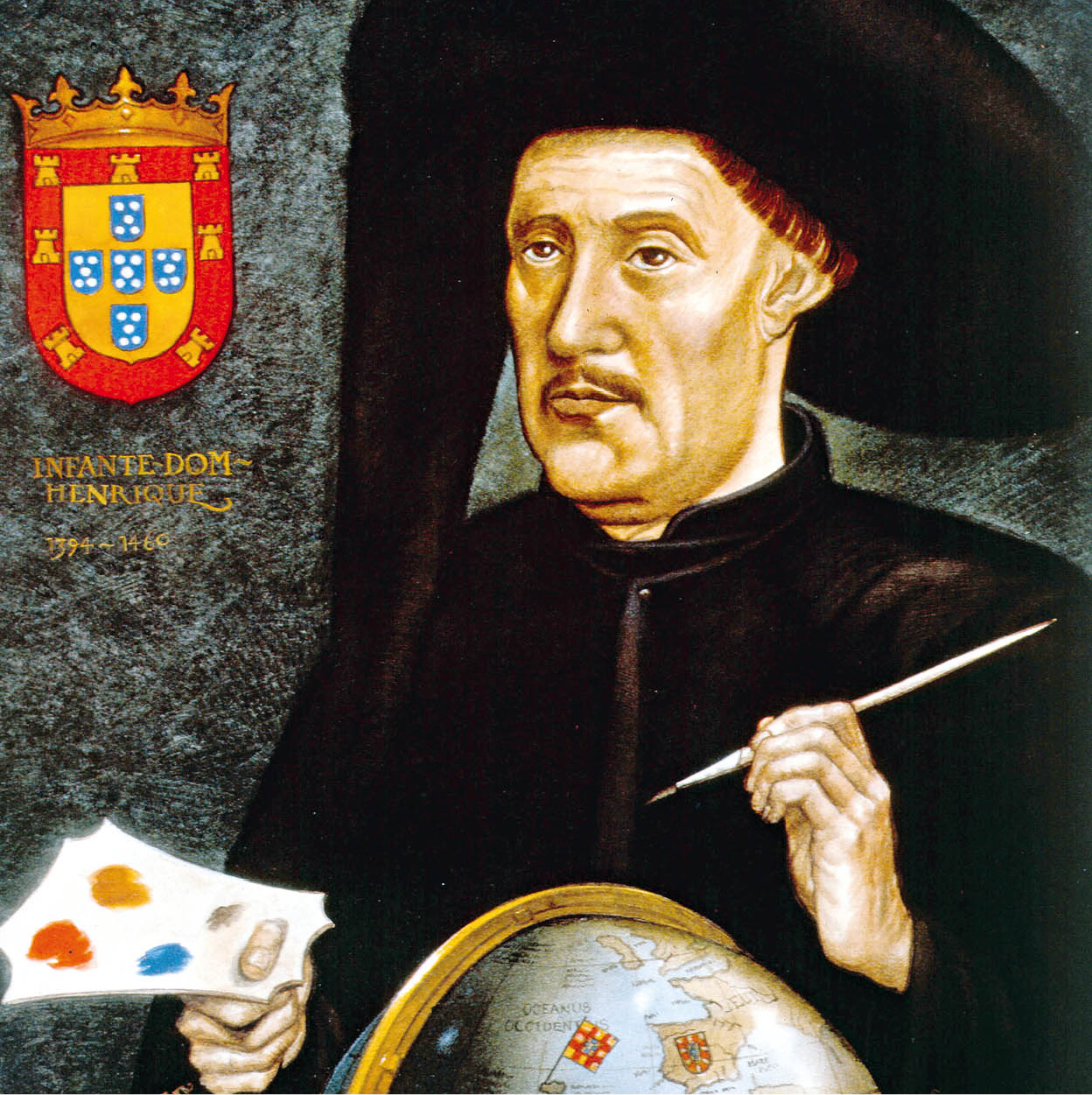
Henry the Navigator, son of John I of Portugal.
Mary Evans Picture Library
Two of Afonso’s uncles were particularly trusted advisers: Henry the Navigator, who was in the forefront of exploration and conquest, and yet another Afonso, the Duke of Bragança, leader of the newly strengthened nobility. Each was granted a large share of independent power. King Afonso himself remained above the administrative fray. He was not particularly inept, but he was a chivalric leader in an era where politics had been sullied by the growing power of mercantiles and low nobility, and he was out of tune with the times. Afonso concerned himself largely with martial glory, which he found crusading in North Africa. In 1471 he took Tangiers. Another of his accomplishments was the minting of the first cruzado, the gold coin that became a symbol of the wealth flowing in from the voyages.
Trade and exploration, it was then thought, would serve both to occupy the nobility and to boost commerce.
In 1475 dispute over the crown of Castile led to civil discord. Afonso married his niece, Joana, one of the claimants, and thus united Portugal and Castile under his monarchy. He invaded in support of his wife’s claims, and occupied León, but failed to hold his ground. Defeated by the forces of Ferdinand of Aragón and Isabela of Castile, he tried to enlist the aid of French king Louis XI in support of his claims to the Castilian throne, travelling to France to make a personal plea. He arrived in the midst of Louis XI’s tumultuous rivalry with the Duke of Burgundy and proved a hapless diplomat, alienating both sides.
Frustrated, he announced his intention of abdicating his throne to go on a pilgrimage to the Holy Land, but even this quixotic voyage was thwarted. Louis prevented him from embarking, and the despondent Afonso was sent back to his homeland. His son, the future João II, allowed Afonso to resume his nominal position, and rule was shared until the older man’s death in 1481.
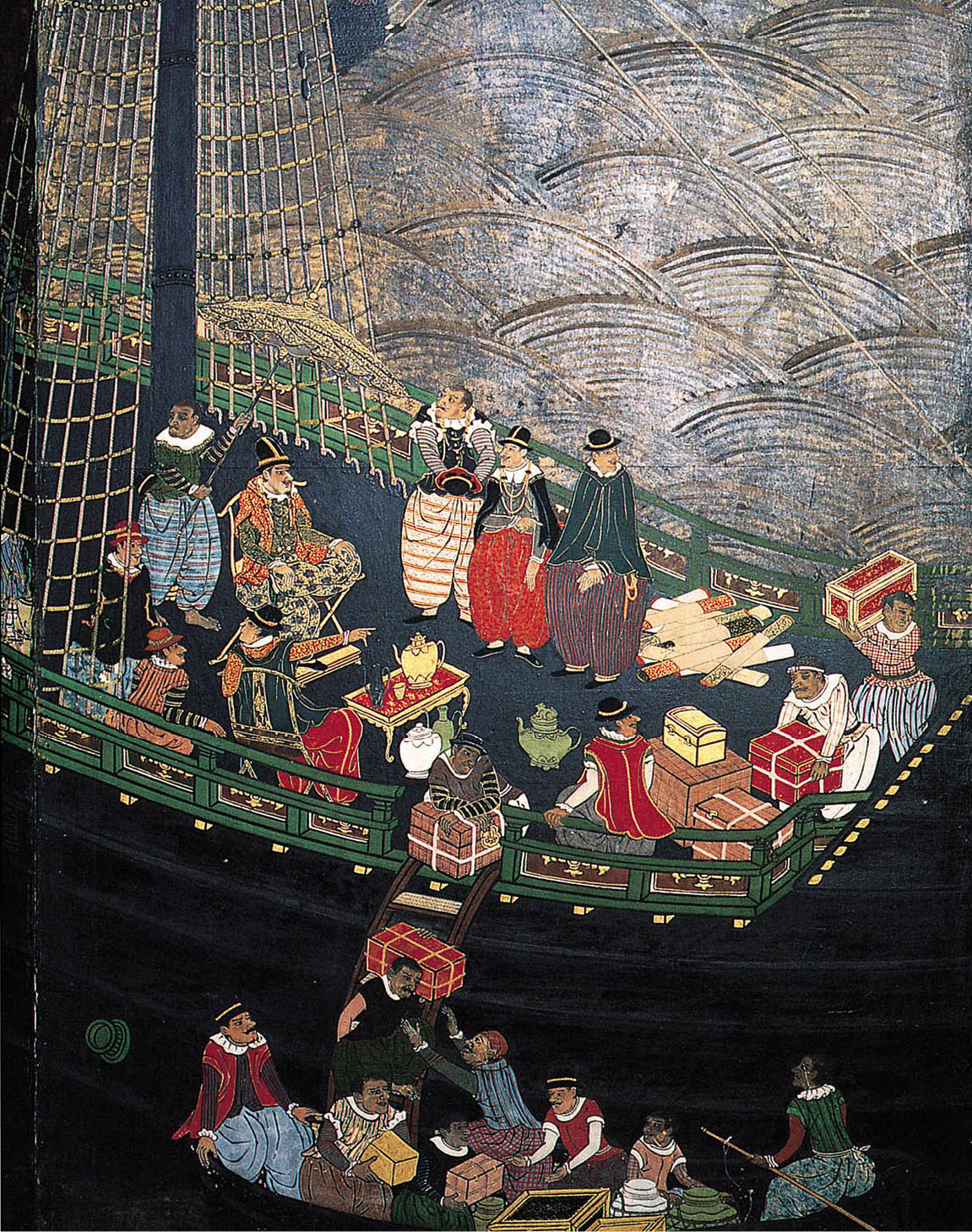
A Japanese screen commemorates the arrival of Portuguese traders.
Museu Nacional de Arte Antiga, Lisbon
Overseas expansion
The 15th century was the era when overseas expansion began in earnest, but no one had any idea of the empire that was to come. The existing policy was a strange mixture of crusading ideals, romantic curiosity and, of course, profit. Charting the world was a secondary matter to João II – less important, for example, than the acquisition of spices, or the search for the odd figure who was known as Prester John.
A mythical priest and king, Prester John was supposed to have been the leader of a vast and powerful Christian empire located somewhere in the African interior. His legend was elaborated with tales of a kingdom that was an earthly paradise peopled with a bizarre menagerie of chimeras and mythical characters. Strange as it seems, this tale had an enormous influence on early exploration of Africa. In fact, in 1455, after the Portuguese had established their dominance all along the northern coast, a papal bull granted them the sole right to discovery and conquest of all Africa except those parts ruled by Prester John. It was only later, by the early 16th century, that Portugal’s explorers began to realise that spices and gold were more tangible goals, and the voyages in and around Ethiopia were replaced by more profitable itineraries.
Another goal of the seafarers was the still-popular slaughter of the infidel. Attacking Muslims wherever they could be found gave the voyages all the benefits of a crusade: the effort was legitimised, and the Church lent its financial resources along with spiritual support. The sanctions of Rome, like the papal bull of 1455, would become an important factor when maritime competition intensified.
Economic and social needs undoubtedly motivated the voyages. There was a shortage of gold all over Europe, and without it, coinage was severely debased and the growth of commerce retarded. Gold from Africa, America and India eventually did find its way into the coffers of Lisbon, but it also proved to be a debilitating obsession, diverting attention from surer if less spectacular sources of profit. These lesser goals were nevertheless an impetus for exploration from the start. Fishing boats had circled further and further out in search of more richly stocked waters. Moroccan grain, sugar, dyestuffs and slaves were all highly prized. These commodities were eventually joined by the pungent spices and rare woods of India and the Orient.
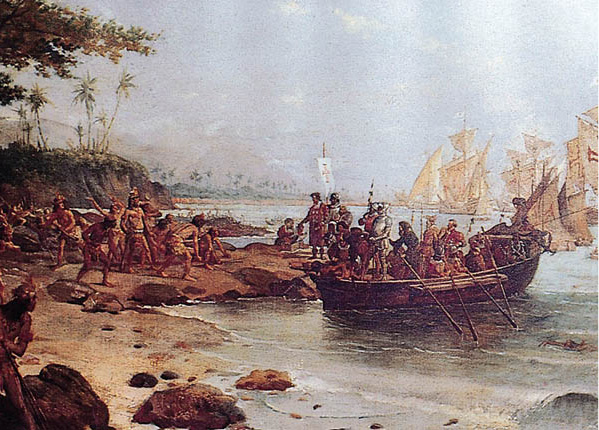
Pedro Alvares Cabral lands in Brazil.
Museu da Marinha, Belem
Henry the Navigator
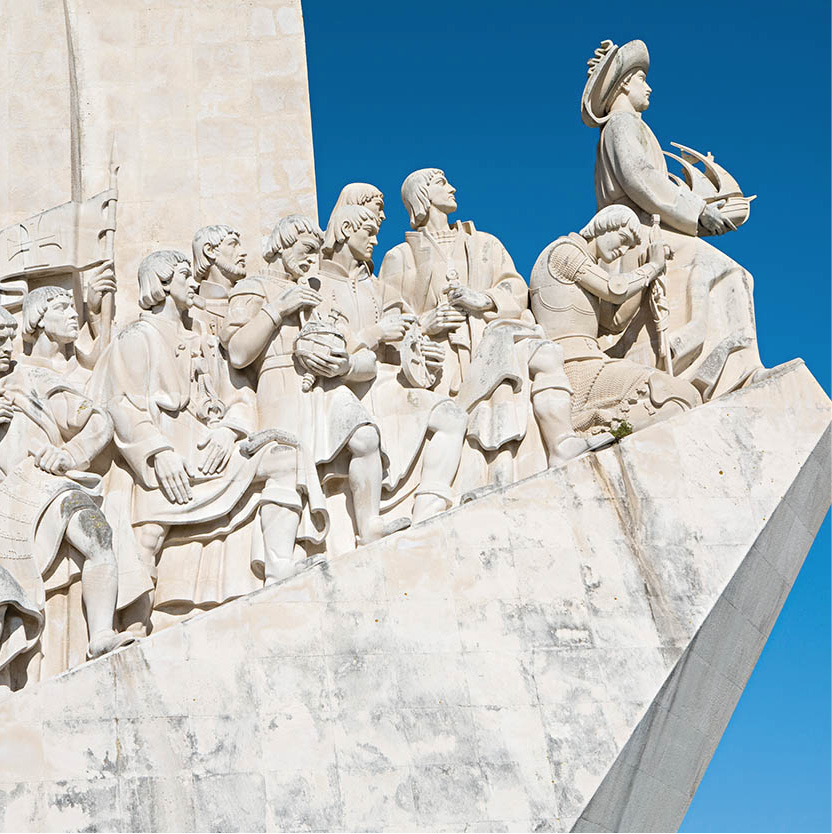
Lisbon’s Padrao dos Descobrimentos celebrates Portuguese explorers from the Age of Discovery.
Lydia Evans/Apa Publications
Before any exploration could begin, of course, the technical aspects of navigation had to be mastered and improved. Navigators familiar with the Pole Star, dead reckoning and the compass began to establish their position with the quadrant, the astrolabe adapted for sea use, and a simple cross-staff from which they calculated latitude. Celestial tables and so-called portolano charts, basic maps, became ever more detailed. Ships, too, radically changed – neatest of all was the nimble caravel, derived from the heftier cargo-carrying caravela of the Rio Douro. Prince Henry, who was born in Porto, would have known it well.
The prince was dubbed Henry the Navigator and is credited with masterminding the discoveries from a centre of navigation in Sagres at Cabo de São Vicente in Algarve, where he surrounded himself with astronomers and shipbuilders. His sponsorship and enthusiasm were profoundly influential, and the research material he assembled was unrivalled (much of it contributed by his brother, Pedro, a true wanderer who sent Henry every relevant map and book he could find). But discovering the world – the Portuguese were the first Europeans to find two-thirds of it – was beyond the scope of any one man, and there must be other, unsung, heroes.
With many hands at the tillers, the enterprise was not always well coordinated. The main goal was to press the crusade forward and to advance knowledge of navigation and the oceans. Maps were accurate enough to suggest that there were islands in the unknown Sea of Darkness, and land beyond it, but it needed courage and determination to sail into oceans that legend had filled with fearsome monsters. (For more on Henry, see panel)
Henry the Hero?
Prince Henry the Navigator’s primary goal, rather than to discover uncharted territory, was the taming of the North African coast. He never travelled farther than Morocco, where he had taken Ceuta in 1415, and gained his lifelong interest in discovery and conquest. Contemporary chronicles portray Henry devoting most of his time to squeezing profits out of his various tithes, monopolies and privileges.
However, the riches uncovered by his expeditions were undeniable, whatever his motivation. It was an expedition initiated by Henry the Navigator that, quite accidentally, discovered Madeira and the Azores. In 1415, two ships were blown off course and landed on the uninhabited island, which they named Madeira (meaning “wood”) because it was thickly forested. The first of the nine Azores (Açores) islands was discovered a dozen years later, the others over a period of 25 years. Henry proved to be an efficient and able coloniser, introducing wheat, vines and sugar cane to Madeira, and organising the settlement of the Azores, which later became recognised ports of call for sailors en route to and from the New World.
Later in life increasing reports of wondrous and far-off places inspired Henry to give the discoveries his full attention. Yet throughout his life he ploughed much of his profits back into the enterprises, which were a costly business, and died in debt.
Epic voyages
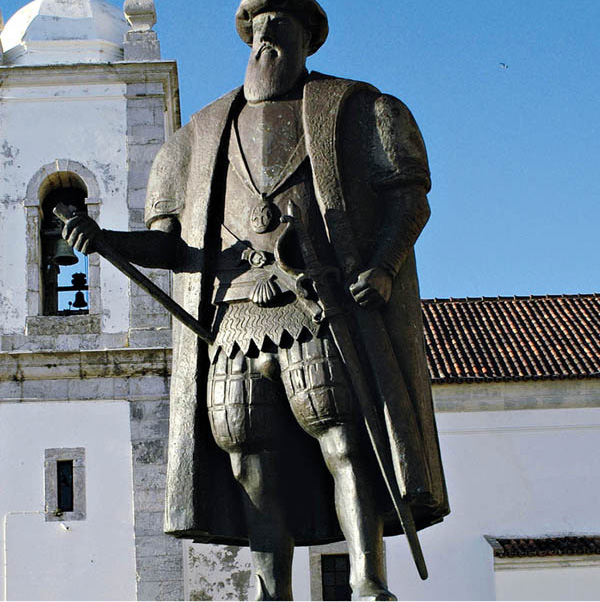
A statue of Vasco de Gama.
Fotolia
It is easy to see why popular history might accord undue credit to an individual like Henry. The Age of Discoveries was a time for heroes and adventurers, and also a time for the rebirth of chivalric ideals. Fearless mariners sailed off into unknown realms. Their voyages were imbued with noble intentions: the greater glory of the Church, the advancement of knowledge, and the benefit of their nation.
Popular history also makes unverifiable, but plausible, claims that Portuguese mariners were the first Europeans in America. Among explorers who sailed from the Azores were members of the Corte Real family, who explored the North American coast in the 1470s. One of them, Miguel, may have been marooned there.
The first hero of the discoveries was Gil Eanes. Madeira and the Azores, along with the north of Africa, had been charted. The islands had begun to be colonised. The fabulous tales of the edge of the world and the various horrors of the southern seas were soon connected with the stormy promontory of Cape Bojador, on the west coast of Africa. It became the boundary. Finally, in 1434, Gil Eanes, a pilot commissioned by Henry the Navigator, broke the barrier. He found more coastline and safe waters, and returned to Portugal triumphant, bringing wild plants plucked from the land beyond. The next year he led voyages further down Africa’s coast, and the way was opened for the many who followed. They searched primarily for the legendary Rio do Ouro (River of Gold). Eventually some of the precious ore was found.
In 1482, Portuguese ships explored the mouth of the Congo. Five years later, Bartolomeu Dias rounded the Cape of Good Hope. So intense did the competition between Spain and Portugal become that in 1494 papal intervention resulted in the famous Treaty of Tordesillas, which divided the newly discovered and the still unknown lands between the two countries. It granted Portugal the lands east of a line of demarcation 592km (370 miles) west of the Azores, which put Brazil (then unknown, but discovered by Pedro Alvares Cabral in 1500) within Portugal’s sphere.
In 1497–9, Vasco da Gama sailed to Calicut (Calcutta) in India and back – with great loss of life – immediately throwing Portugal into competition with Muslim and Venetian spice traders. In 1519–22, Fernão de Magalhães (anglicised to Ferdinand Magellan), a Portuguese serving Spain, led the first voyage to circumnavigate the globe, although he died before it was completed.
The Portuguese began fishing for cod (bacalhau) in Newfoundland’s Grand Banks shortly after Columbus’s voyage of discovery. It soon became a very popular dish.
The expeditions opened the seaways, but there were battles to be fought to establish trading posts in Africa and the Indies. Arabs, protecting their own trade interests, fought the Portuguese wherever they could. The Portuguese, of course, were still intent on eradicating such infidels from the face of the earth. So although Portugal originally had no intentions of land conquest, by simply striving to establish and maintain a monopoly of the high seas, they were constantly at war.
Colonies
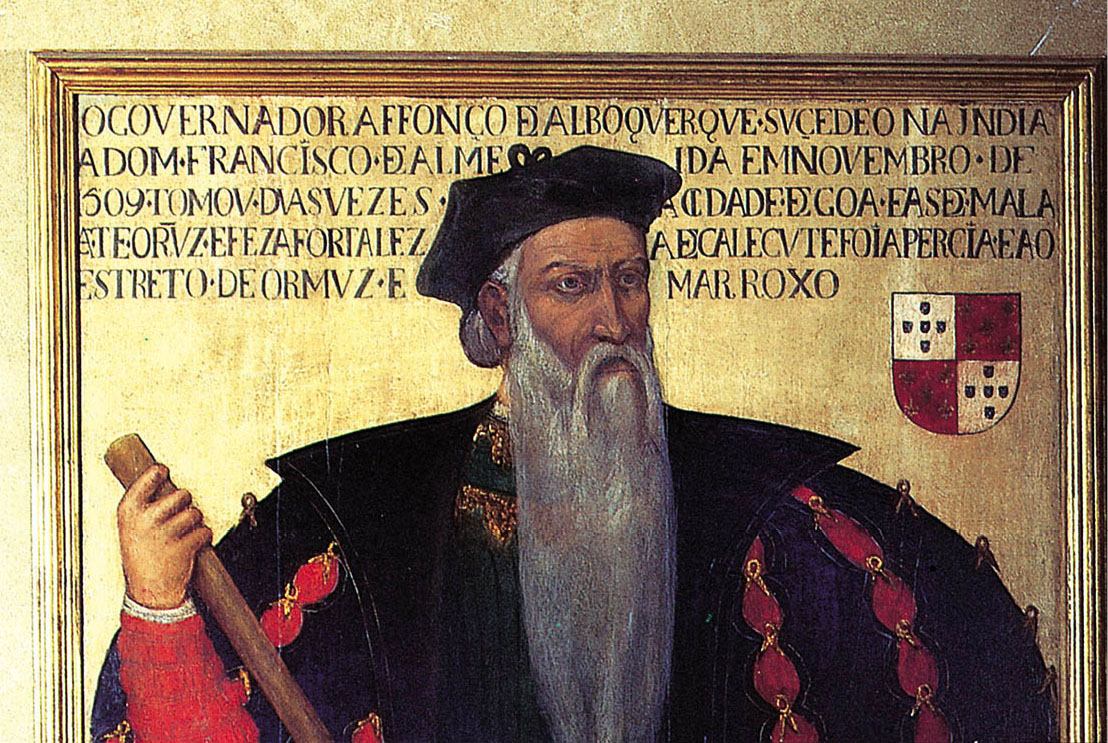
Afonso de Albuquerque, painted by an unknown artist, c.1509.
Museu Nacional de Arte Antiga, Lisbon
The leader of these voyages of eastern exploration was Governor Afonso de Albuquerque, a brilliant strategist and, in essence, the founding father of the empire in Asia. His victories allowed garrisoned ports and fortresses to be built in key locations. Goa, in India, conquered in 1510, became the centre for all operations. Malacca (now in Malaysia) fell in 1511 and served as the East Indies hub, while Ormuz came under Portuguese control in 1515, proving the ideal seat from which to dominate the Persian Gulf. Later, in 1557, Macau was established on a kind of permanent lease with China, extending Portugal’s reach to the Far East.
Portugal administered these new holdings under a basic policy of colonisation rather than exploitation. All the major cities, Goa in particular, were converted by architecture and government into European towns. Interracial marriages were encouraged and Catholic missions established.
The growth of Goa was extraordinary. By 1540, there were 10,000 households of European descent and the town was the seat of a bishopric. However, these few much-changed cities and the battles of the Indies were in marked contrast to the general policy of peaceful coexistence that Portugal adopted wherever it could. In Africa, Brazil, and the various islands and archipelagos, they tried to set up trading stations without interfering with local customs or politics.
It is, however, the exceptions that proved the most interesting. In the Congo, for example, where a number of missions were established, the people were quite taken with their European visitors, though they could provide little of interest to the traders. The Portuguese had begun by overestimating the political and cultural sophistication of these people, and once the Congolese were exposed to certain Western practices, they embraced them rapidly. They took to Christianity, and imitated the manners and fashions of the Portuguese. Their first Christian monarch dropped the title “Nzinga a Nkuwu” and renamed himself João I. His son took the name Afonso, and from that point until the 17th century the land was ruled by a succession of native Henriques, Pedros and Franciscos.
Although it provided both ivory and slaves, the Congo was not of central economic importance to the Portuguese, who were too busy reaping bounty elsewhere: spices were carried from the east, gold was found in Ghana and other parts of Africa, sugar and wine were brought from Madeira, while sugar and dye-stuffs came from Brazil.
The wealth reaped overseas made for a stable economy, but it did not make Portugal rich. Enterprising individuals and the monarchy – taking its royal fifth of all trade revenues – flourished, but even they eventually found it difficult to build or hold on to their fortunes.
At its beginning, the ‘‘empire’’ demanded little from its diminutive fatherland. Like other small trading centres in Italy and the later Dutch empire, organisation and central authority were more important than mere size. Furthermore, the early expeditions required little manpower. It was only later, when they found themselves trying to enforce the worldwide trade monopoly, that the sparseness of Portugal’s population began to tell. It has also been suggested that a crucial deficiency was Portugal’s lack of a middle class. Quashed by royal and noble dominance of commerce, it might have provided qualified and educated planners, pilots and administrators.
In explaining the empire’s failure, some have pointed to widespread corruption or to the foreign control of profits garnered from Portuguese expeditions. How great an effect they had is arguable. Certainly the religious efforts that went hand in hand with Portuguese voyages did not make the wheels of commerce spin any more freely. Whether fighting Muslims, or trying to force Christianity down the throats of local populations, the Portuguese wasted time and diverted their focus from the business at hand.
Whatever the causes, potential benefits of the burgeoning overseas trade were not being reaped. Deflation in Europe stifled trade. Domestic agricultural production, hampered by a lack of manpower, lagged, occasionally causing serious shortages of meat and grain. Even the Crown was in debt, as the cost of the trading empire rose higher than its revenues. It was, of course, many years before these flaws and inadequacies truly sank the empire. Trade was to continue for several centuries, although it steadily deteriorated.

Azulejo of a Portuguese expedition ship.
Corbis
The Jews in Portugal
As moneylenders, tax collectors, bankers, physicians and astronomers, the Jews had, by the 15th century, lived peaceably in Portugal for a thousand years or more. In 1492, Spain, having rid itself of the Moors, was equally determined to expel the Jews from its soil. Some 60,000 were allowed to settle in Portugal.
The contribution of the Jews to the economy and progress of the country was already invaluable, and their influence was increasing. It was the Jews who opened Portugal’s first printing presses, and the first 11 books published were all in Hebrew. Abraham Zacuto, astronomer and mathematician, published the Almanach Perpetuum, which contained tables enabling mariners to determine latitude by declination of the sun. The Almanach was translated into Latin and became the basis of a system used by the Portuguese for many years.
When King Manuel married Princess Isabella of Spain in 1497, he was forced, as a condition of marriage, to act against the Jews. Realising their value to the country, he was reluctant to expel them so he offered them the option of baptism as “New Christians”, with a 20-year period of grace before their faith would be tested. Many refused outright, and those who accepted soon found that they were not treated as equals. Prejudice and intolerance were quick to burgeon into full-scale repression as the Inquisition took hold.
Domestic life
Before the slide began, the lucrative age of empire brought sufficient peace and prosperity for Portugal to sustain great eras of artistic and humanist achievement. João II had taken over from his father, the unreliable Afonso V, in 1481. Revitalising the throne, he managed to take up where Henry the Navigator, who died in 1460, left off. João turned away from the nobility, minimising their rights and calling on the cortes for support. A conspiracy soon gathered against him, but he learned of the central traitors soon enough to strike back. In 1484, the Duke of Bragança was tried and beheaded. When other members of the nobility fled the country, their titles and holdings reverted to the Crown.
The Duke of Viseu, who was both cousin and brother-in-law to the king, unwisely mounted a second plot, and was stabbed by the king himself. Another group fled the country, and João II was left in full command. The prestige and authority that these tactics bestowed on the monarchy would stand undiminished for centuries. However, João’s successor, Manuel I, who came to the throne in 1495, had to find a balance between the ferocity of his predecessor and the confused idealism of Afonso V.
This he accomplished through diplomatic and far-sighted administration. The estates of the noble families were largely restored, though this did not restore their political power. Judicial and tax reforms worked to bring authority to government on both the national and local levels. A postal system was instituted. Public services such as hospitals were centralised. Essentially, Manuel lifted the power of the monarchy above both the nobles and the cortes, launching the first era of enlightened absolutism.

João III, in a portrait by Cristovão Lopes.
Biblioteca Nacional, Lisbon
The importance of education
Manuel also fostered contacts with proponents of Renaissance humanism, which was then spreading throughout Europe. There were many trading, religious and cultural contacts with Italy in particular, and young Portuguese men began to seek education abroad, at universities in France or Spain.
Manuel tried to buy Paris’s renowned St Barbara College, and, although he failed, it became a centre for Portuguese students. By 1487 a printing press had been established in Lisbon. Portugal entered the 16th century with a rush of new cultural currents and ideas.
New colleges and educational reforms were basic elements of the new century’s progress. Teaching methods were modernised and the curriculum expanded. The students were drawn from a larger pool, including aristocrats and members of the wealthy bourgeoisie, in addition to young men from the religious orders.
These changes were not without crises. The University of Lisbon had a cultural and political influence that threatened the Crown. It was difficult to impinge on its traditional autonomy, but Manuel, as part of his process of centralisation, tried to force change through economic and legal pressure.
Finding great resistance, he turned to the idea of founding a new university elsewhere, without success. João III, who came to the throne in 1521, on his father’s death, continued these efforts, later giving control of national education to the Jesuits and moving the university to Coimbra, where its permanent home was established. It was a victory for the monarchy. There would be no university in Lisbon until 1911.
Nonetheless, the century inspired a broad-ranging intellectual vigour. Some of the works produced were directly attributable to the expeditions of discovery. Travel books, with both scientific and cultural themes, were a rich vein: Tomé Pires, for example, wrote Suma Oriental in 1550, describing his voyages to the East.
Portugal’s main contributions to the intellectual ferment of the Renaissance were in science, particularly navigation, astronomy, mathematics and geography. This was not the mere accumulation of facts from foreign places: they amounted to a kind of sceptical empiricism, a science based on experience. Having disproved a dozen theories about the shape, limits and contours of the earth, Portuguese intellectuals felt free to question the other dogmas of antiquity.
João III continued Manuel’s expansion of the trading empire and of royal authority, but his most significant act was the establishment of the Inquisition in Portugal.
New writers and new sciences were emerging but there was no real Reformation in Portugal, where there was an antipathy towards Germanic philosophies. Nevertheless, the Counter-Reformation cast a pall of religious conformism over learning and creativity. In addition, the political threat to Portuguese autonomy – the future union with Spain was already an undercurrent – hung over all these academic achievements.

Heretics are led to their death by fire in an auto-da-fe procession.
Biblioteca Nacional, Lisbon
Portuguese Inquisition
João III ruled from 1521 to 1557. The Inquisition had by now become established in Spain, where it had been enforced with vigour after the Moors had been expelled in 1492 by the “Catholic Monarchs”, Isabel and Ferdinand. The papacy knew there was no real need for it, no menaces to the unity of faith, so resisted its introduction. But João III was more fanatical than the pope and he used every diplomatic intrigue at his disposal to get his way. Finally, in 1536, he won approval for a limited version of the Inquisition, but within a dozen years these limitations had been lifted and its full force arrived.
João III had turned away from the current humanist influences of Europe towards religious fanaticism, and the power and the bureaucracy of the Inquisition expanded rapidly. Its main target was the converted Jews known as New Christians. What had been intended as a tool of the monarchy soon took on a direction and authority of its own. The Inquisitor-Generals, who took their orders from Rome, had the right of excommunication and, utilising the spectacular autos-da-fe, the public burning of heretics, soon wielded an influence far beyond their legal authority.
The impact of the Inquisition, with its rigid orthodoxy, vengeful judiciary and general intolerance, was deadening to both culture and commerce. Many of the bourgeois leaders of trade were targets. In those uncertain times, epic poet Luís de Camões and the great 16th-century playwright Gil Vicente became renowned for their works in the Portuguese language.
The Inquisition’s power continued under King Sebastião, who came to the throne in 1568, when he was 14 years old. An unstable and idealistic king, with a dangerous streak of misplaced chivalry, Sebastião took upon himself a crusade against the Moors of North Africa. A lack of funds prevented him from undertaking the task for many years. In the meantime he surrounded himself with cohorts no older and no more sensible than himself, dismissing the warnings of older, more prudent statesmen. Finally sensing that the time was right, he spent every cruzado he could raise on mercenaries and outfitting his troops. He set sail for Morocco in 1578, appointing his great-uncle, Cardinal Henrique, regent in his absence.
Sebastião was as bad a military leader as he was an administrator, dismissing stratagem and planning as cowardice. He refused to consider the possibility of retreat, and therefore had no plan for it. Outnumbered and outmanoeuvred at the Battle of Alcácer-Quibir, his army of 18,000 men was destroyed. Some 8,000, including Sebastião and most of Portugal’s young nobility, were slaughtered. Only 100 or so escaped.
In the wake of this debilitating disaster, the way was open for Spain to step in. From 1578 to 1580, Cardinal Henrique ruled the country, occupied primarily with raising the ruinous ransoms for the captured soldiers of Alcácer-Quibir. In 1580, Felipe II of Spain invaded and within a year was installed as Filipe I of Portugal.
Luís de Camões
Portugal’s greatest poet never reaped fame or riches in his lifetime, but his life and his works still entrance the Portuguese today.
Luís Vaz de Camões (1524–80), Portugal’s greatest poet, was born poor, and he died poor, but the life he led – of passion and adventure – enthrals the Portuguese almost as much as the epic, eloquent phrases in his works, which many people can quote at length even today.
After attending the University at Coimbra, his prospects were good. But many twists of fate lay ahead. An affair with one of the queen’s ladies-in-waiting caused his banishment to North Africa, where he lost an eye in military service. Returning to Lisbon, Camões was involved in a skirmish that wounded a magistrate. He ended up in prison and then was banished again, in 1553, this time to the colony of Goa in India.
It was 1570 before he returned to Lisbon. Having written poetry and plays for many years with some success, he published Os Lusíadas in 1572. The poem’s worth was recognised immediately, and Camões received a small royal pension. His final illness, however, was spent in a public hospital, and he was buried in a common grave.
The title Os Lusíadas means “The Sons of Lusus”, the mythical founder of Portugal: symbolically, then, it means “the Portuguese”. Echoing classical models, the poem chronicled the voyages of Vasco da Gama, before a panorama of strangely mixed Christian and pagan images.
Os Lusíadas has been hailed throughout Europe (Lope de Vega and Montesquieu were among early admirers), sometimes to the detriment of the rest of Portugal’s extensive literature. Under Salazar (for more information, click here), Os Lusíadas became an icon of Portuguese nationalism. Speeches and propaganda were peppered with quotes from it, providing a mythology for imperialism that failed to differentiate between the 16th and 20th centuries.
The 18th-century verse translation by W.J. Mickle, quoted below, though tinged with the lyrical romanticism and chauvinism of that era, captures the proud spirit of the poem from the opening lines:
Arms and the heroes, who from Lisbon’s shore,/ Thro’ seas where sail was never spread before,/ Beyond where Ceylon lifts her spicy breast,/And waves her woods above the watery waste,/With prowess more than human forc’d their way/ To the fair kingdoms of the rising day.
In the second canto the Moors prepare to attack:
On shore the truthless monarch arms his bands,/ And for the fleet’s approach impatient stands:/ That soon as anchor’d in the port they rode/ Brave Gama’s decks might reek with Lusian blood:/.
In the world of the Portuguese discoverers, enemy forces take their strength from the netherworld:
As when the whirlwinds, sudden bursting, bear/ Th’ autumnal leaves high floating through the air;/ So rose the legions of th’ infernal state,/ Dark Fraud, base Art, fierce Rage, and burning Hate:/ Wing’d by the Furies to the Indian strand/ They bend; the Demon leads the dreadful band,/ And in the bosoms of the raging Moors/ All their collected living strength he pours.
At Vasco da Gama’s request, his ship’s chronicler recounts the “glad assistance” brought by the crusaders who helped take Lisbon from the Moors:
Their vows were holy, and the cause the same,/ To blot from Europe’s shores the Moorish name./ In Sancho’s cause the gallant navy joins,/ And royal Sylves to their force resigns./ Thus sent by heaven a foreign naval band/ Gave Lisboa’s ramparts to the Sire’s command.
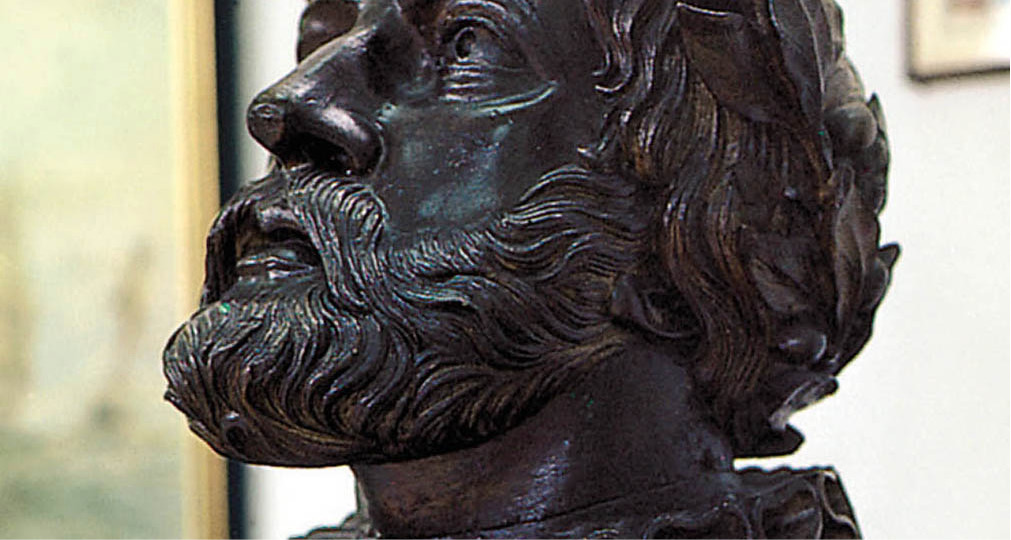
Luís de Camões.
Museu Militar, Lisbon